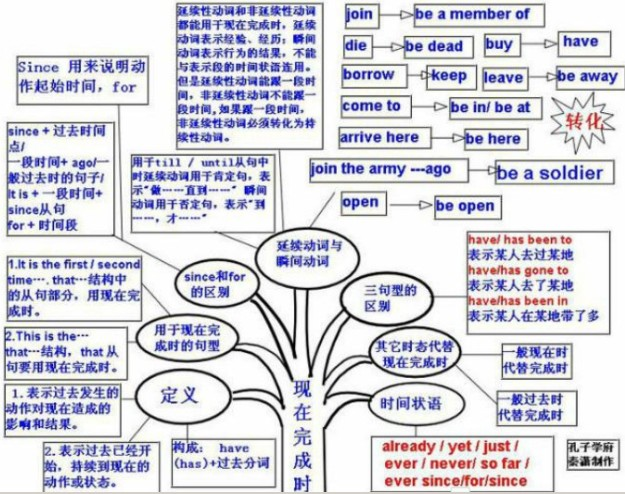本试题 “It's the third time _______ late this month. [ ]A. that you arrivedB. when you arrivedC. that you've arrivedD. when you've arrived” 主要考查您对现在完成时
强调句
等考点的理解。关于这些考点您可以点击下面的选项卡查看详细档案。
- 现在完成时
- 强调句
现在完成时的概念:
现在完成时用来表示之前已发生或完成的动作或状态,其结果的影响现在还存在;也可表示持续到现在的动作或状态。其构成:have(has)+过去分词。
现在完成时共有四种主要用法:
一、现在完成时表示影响:
该用法的现在完成时表示一个过去发生的动作在过去已经完成,并且这个过去发生并完成的动作对现在有影响或结果,同时说话者强调的或感兴趣的就是这个影响或结果,如汉语说“他已离开这个城市了”,其中的“离开”肯定发生了,它对现在的影响或结果就是“他现在已不在这个城市了”;又如汉语说“有人把窗户打破了”,显然“打破窗户”这一动作发生在过去,并且在过去已经完成了,但说话人强调的重点是打破窗户对现在的影响—窗户现在仍是破的。
如:He has left the city. 他已离开这个城市。(结果:他不在这个城市。)
Someone has broken the window. 有人把窗户打破了。(结果:窗户仍破着。)
I have lost my pen. 我把钢笔丢了。(结果:我现在无钢笔用。)
He has finished his work. 他把工作做完了。(结果:他现在可以做其他的事了。)
二、现在完成时表示持续:
该用法的现在完成时表示一个过去发生的动作或开始的状语在过去并未完成或结束,而是一直持续到现在,并且有可能继续下去(也可能到此结束),如汉语说“他在我们学校教书已有30年了”,显然“他在我们学校教书”是从30年前开始,并且一直教到现在,已经持续了30年;又如汉语说“自上个星期以来他一直很忙”,显然“忙”是从上个星期开始的,并且这一“忙”就一直忙到现在。
如:He has taught in our school for 30years. 他在我们学校教书已有30年了。
He has been busy since last week. 自上个星期以来他一直很忙。
He has worked for us ever since he left school. 他离开学校以后就一直为我们工作。
三、现在完成时表示重复:
即表示从过去某个时间直到现在的这个时间范围内不断重复发生的动作或情况,并且这个不断重复的动作有可能继续下去,也有可能到现在就结束。
如:How often have you seen her? 你隔多少见她一次?
My father has always gone to work by bike. 我父亲一向骑车上班。
四、现在完成时表示将来:
同一般现在时可以表示将来一样,现在完成时也可以在时间状语从句里表示将来。
如:I'll wait until he has written his letter. 我愿等到他把信写完。
When you have rested, I'll show you the garden. 等你休息好之后,我领你看我们的花园。
现在完成时知识体系:

比较一般过去时与现在完成时:
1)一般过去时表示过去某时发生的动作或单纯叙述过去的事情,强调动作;现在完成时为过去发生的,强调过去的事情对现在的影响,强调的是影响。
2)一般过去时常与具体的时间状语连用,而现在完成时通常与模糊的时间状语连用,或无时间状语。一般过去时的时间状语:yesterday, last week,…ago, in1980, in October, just now等,皆为具体的时间状语。现在完成时的时间状语:for, since, sofar, ever, never, just, yet, till/until, up to now, in past years,always等,皆不确定的时间状语。共同的时间状语:this morning, tonight, this April, now, already, recently, lately等。
3)现在完成时可表示持续到现在的动作或状态,动词一般是延续性的,如live, teach, learn, work, study, know。一般过去时常用的非持续性动词有come, go, leave, start, die, finish, become, get married等。
例如:I saw this film yesterday.(强调看的动作发生过了)
I have seen this film.(强调对现在的影响,电影的内容已经知道了)
Why did you get up so early?(强调起床的动作已发生过了)
Who hasn't handed in his paper?(强调有卷子未交,疑为不公平竞争)
He has been in the League for three years.(在团内的状态可延续)
He has been a League member for three years.(是团员的状态可持续)
句子中如有过去时的时间副词(如yesterday, last, week, in1960)时,不能使用现在完成时,要用过去时。
(错)Tom has written a letter to his parents last night.
(对)Tom wrote a letter to his parents last night.
强调句的概念:
强调句 (The Emphatic Pattern) 是一种修辞,是人们为了表达自己的意愿或情感而使用的一种形式。通过各种方式对句子中的某个部分进行强调,从而起到修辞的作用。英语常用的强调结构有:It is (was)+被强调部分(主语、宾语或状语)+that/who...;what…be…句型;
强调句的使用:
一、强调句句型:
1、用It is/was...that/who...句型表示强调。
(1)陈述句的强调句型:It is/was+被强调部分(通常是主语、宾语或状语)+that/who(当强调主语且主语指人)+其它部分。
e.g. It was yesterday that he met Li Ping.
(2)一般疑问句的强调句型:同上,只是把is/was提到it前面。
e.g. Was it yesterday that he met Li Ping?
(3)特殊疑问句的强调句型:被强调部分(通常是疑问代词或疑问副词)+is/was+it+that/who+其它部分?
e.g. When and where was it that you were born?
注:被强调的部分(通常是句子的主语、状语、宾语或宾语补足语)放在is/was的后面,如被强调的是人,则后面可用who,whom等代替。
如:原句:He met an old friend in the park yesterday.
强调主语:It was he who/that met an old friend in the park yesterday.
强调宾语:It was an old friend that/who he met in the park yesterday.
强调地点状语:It was in the park that he met an old friend yesterday.
强调时间状语:It was yesterday that he met an old friend in the park.
2、用助动词do, does或did来强调谓语动词。
如:Do come early.
He did send you a letter last week.
We're pleased that she does intend to come.
3、用主语从句+be+被强调部分,主语从句常用what引导。
如:What John wants is a ball.
What Mary does every day is(to) give piano lessons.
二、not...until...句型的强调句:
1、句型为:It is/was not until+被强调部分+that+其它部分:
e.g. 普通句:He didn't go to bed until/till his wife came back.
强调句:It was not until his wife came back that he went to bed.
2、注意:此句型只用until,不用till。但如果不是强调句型,till, until可通用;
因为句型中It is/was not...已经是否定句了,that后面的从句要用肯定句,切勿再用否定句了。
三、谓语动词的强调:
1、It is/was...that...结构不能强调谓语,如果需要强调谓语时,用助动词do/does或did。
e.g. Do sit down.务必请坐。
He did write to you last week. 上周他确实给你写了信。
Do be careful when you cross the street. 过马路时,务必(千万)要小心啊!
2、注意:此种强调只用do/does和did,没有别的形式;过去时用did,后面的谓语动词用原形。
使用强调句型有以下几点请注意:
①强调句的谓语is或was永远用单数。
如:It was yesterday that I met your father in the street.
②不管被强调部分是哪种状语,只能用that连接,不得使用where、when等连词。
如:It was in the street that I met your father yesterday.
③被强调部分为人时,可用who(主格或宾格)和whom(宾格)代替that,用that也行。
如:It was your father that/whom/who I met in the street yesterday.
It was I that/who met your father in the street yesterday.
④强调句中也要注意主谓一致、人称一致和否定转移的问题。
如:It is they who are our friends.
It was not until ten o'clock that we got home last night.
⑤注意不要混淆强调句和其他从句。It is/was...that...为强调句标志,去掉后仍可组成一个完整的句子,只是没被强调,而其他从句一般不具备这一特征。
比较:1)It was ten o'clock when we got home last night. 我们昨晚到家时已十点了。
2)It was at ten o'clock that we got home last night. 我们昨晚是在十点到家的。
第一句不是强调句,when不可改为that,因为去掉it was和that后,只能组成“We got home ten o'clock last night.”这样一个不完整的句子;第二句是强调句,that不可改为when。
强调句型用法拓展:
1、句首词用“It”,不能用“This”,“That”等。
2、be动词的形式是is或was,不能用复数形式are或were。若原句的谓语动词用了现在时或将来时,则用is;
若原句的谓语动词用了过去时或过去完成时,则用was。
如:It___the Chinese women that___a great role in the socialist construction.
A. is; plays
B. are; play
C .is; play
D. are; plays
答案:C
3、被强调的部分如果是代词,强调主语用主格,强调宾语用宾格。
如:It is him that/who/whom I met in the street yesterday.
It is I who/that am wrong.
4、连接词一般用that,当强调部分是人时,既可用that也可用who。特别注意当强调部分是时间状语或地点状语时,不能用when或where。
如:It was on Oct1st, 1949 that People's Republic of China was founded.
It was at the gate____he told me the news.
A. that
B. what
C. which
D. when
答案:A
5、主谓一致问题被强调的主语要和that后面的谓语动词在数上保持一致。
如:It is Mary who often _____(help) me with my English. (helps)
It is I that ____(be) against you. (am)
6、not...until结构的强调。
强调“not...until”引导的时间状语时,要用“it is/was not until...that...”结构,that后面的句子要用肯定式,且须用陈述句语序。
如:We did not get off the bus until it stopped. ?
It was not until it stopped that we got off the bus. (注意:强调该结构时not until不能分开)
与“It's the third time _______ late this month. [ ]A. that y...”考查相似的试题有:
- It is the third time that China _____ people into space.[ ]A. has sentB. sendsC. will sendD. had sent
- Could it be in the restaurant ______ you had dinner with me yesterday _______ you lost your handbag?A.that; whichB....
- If you try to understand _____ that prevents so many Americans from being as happy as one might expect,it seems that ...
- All the people in the nation can remember exactly how many years ago _______ the civil war broke out.A.was it thatB...
- —_____ that he picked up his uncle at the airport?—It was at 6:00 in the afternoon _____ he got off work. A.Was it w...
- — Was it by cutting down staff_ _she saved the firm?— No, it was by improving work efficiency.[ ]A. whenB. whatC. how...
- 单句改错1. It is only when he comes back can you leave.2. A child as he is,he knows a lot about computer games.3. In ...
- — Who is making so much noise in the garden?— ____ the children.[ ]A. There areB. They areC. That isD. It is
- It was not he took off his dark glasses I realized he was a famous singer.A.when; thatB.until; thatC.until; whenD...
- It was not until dark _____ he found _____ he thought was the correct way to solve the problem.[ ]A. that; whatB. tha...